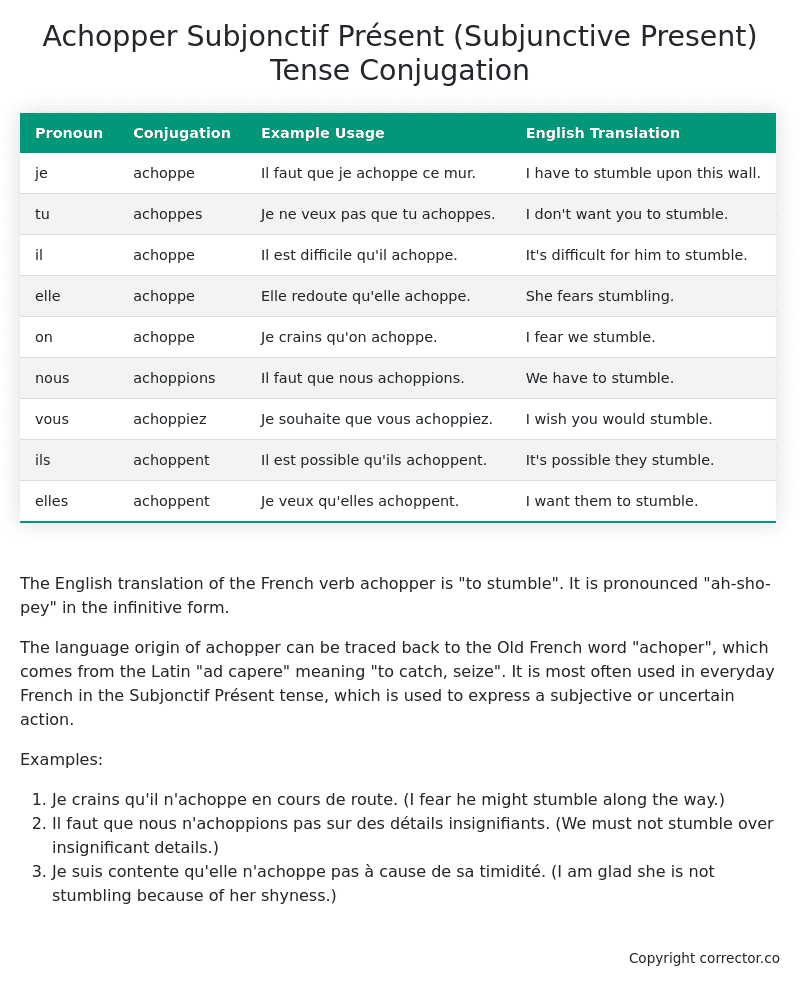Subjonctif Présent (Subjunctive Present) Tense Conjugation of the French Verb achopper
Introduction to the verb achopper
The English translation of the French verb achopper is “to stumble”. It is pronounced “ah-sho-pey” in the infinitive form.
The language origin of achopper can be traced back to the Old French word “achoper”, which comes from the Latin “ad capere” meaning “to catch, seize”. It is most often used in everyday French in the Subjonctif Présent tense, which is used to express a subjective or uncertain action.
Examples:
- Je crains qu’il n’achoppe en cours de route. (I fear he might stumble along the way.)
- Il faut que nous n’achoppions pas sur des détails insignifiants. (We must not stumble over insignificant details.)
- Je suis contente qu’elle n’achoppe pas à cause de sa timidité. (I am glad she is not stumbling because of her shyness.)
Table of the Subjonctif Présent (Subjunctive Present) Tense Conjugation of achopper
| Pronoun | Conjugation | Example Usage | English Translation |
|---|---|---|---|
| je | achoppe | Il faut que je achoppe ce mur. | I have to stumble upon this wall. |
| tu | achoppes | Je ne veux pas que tu achoppes. | I don’t want you to stumble. |
| il | achoppe | Il est difficile qu’il achoppe. | It’s difficult for him to stumble. |
| elle | achoppe | Elle redoute qu’elle achoppe. | She fears stumbling. |
| on | achoppe | Je crains qu’on achoppe. | I fear we stumble. |
| nous | achoppions | Il faut que nous achoppions. | We have to stumble. |
| vous | achoppiez | Je souhaite que vous achoppiez. | I wish you would stumble. |
| ils | achoppent | Il est possible qu’ils achoppent. | It’s possible they stumble. |
| elles | achoppent | Je veux qu’elles achoppent. | I want them to stumble. |
Other Conjugations for Achopper.
Le Present (Present Tense) Conjugation of the French Verb achopper
Imparfait (Imperfect) Tense Conjugation of the French Verb achopper
Passé Simple (Simple Past) Tense Conjugation of the French Verb achopper
Passé Composé (Present Perfect) Tense Conjugation of the French Verb achopper
Futur Simple (Simple Future) Tense Conjugation of the French Verb achopper
Futur Proche (Near Future) Tense Conjugation of the French Verb achopper
Plus-que-parfait (Pluperfect) Tense Conjugation of the French Verb achopper
Passé Antérieur (Past Anterior) Tense Conjugation of the French Verb achopper
Futur Antérieur (Future Anterior) Tense Conjugation of the French Verb achopper
Subjonctif Présent (Subjunctive Present) Tense Conjugation of the French Verb achopper (this article)
Subjonctif Passé (Subjunctive Past) Tense Conjugation of the French Verb achopper
Subjonctif Imparfait (Subjunctive Imperfect) Tense Conjugation of the French Verb achopper
Subjonctif Plus-que-parfait (Subjunctive Pluperfect) Tense Conjugation of the French Verb achopper
Conditionnel Présent (Conditional Present) Tense Conjugation of the French Verb achopper
Conditionnel Passé (Conditional Past) Tense Conjugation of the French Verb achopper
L’impératif Présent (Imperative Present) Tense Conjugation of the French Verb achopper
L’infinitif Présent (Infinitive Present) Tense Conjugation of the French Verb achopper
Struggling with French verbs or the language in general? Why not use our free French Grammar Checker – no registration required!
Get a FREE Download Study Sheet of this Conjugation 🔥
Simply right click the image below, click “save image” and get your free reference for the achopper Subjonctif Présent tense conjugation!

Achopper – About the French Subjonctif Présent (Subjunctive Present) Tense
Formation of the Subjonctif Présent
Common Everyday Usage Patterns
Interactions with Other Tenses
Summary
I hope you enjoyed this article on the verb achopper. Still in a learning mood? Check out another TOTALLY random French verb conjugation!


